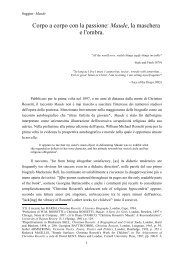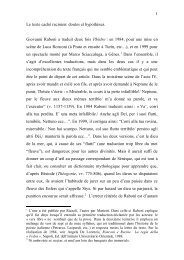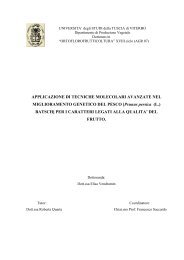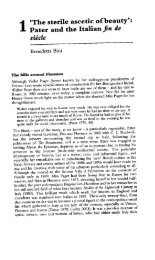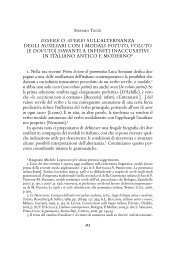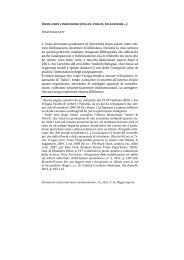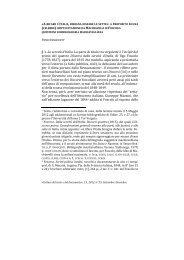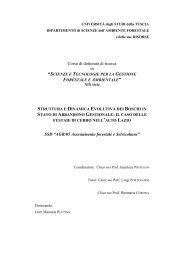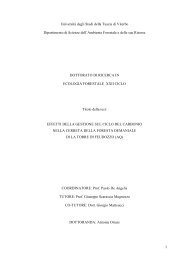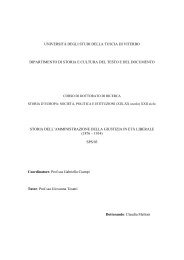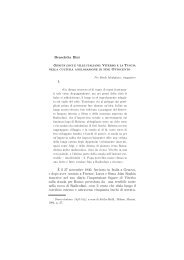drivers of soil respiration of root and microbial ... - Unitus DSpace
drivers of soil respiration of root and microbial ... - Unitus DSpace
drivers of soil respiration of root and microbial ... - Unitus DSpace
Create successful ePaper yourself
Turn your PDF publications into a flip-book with our unique Google optimized e-Paper software.
2.4.2. Diurnal, seasonal <strong>and</strong> inter-annual variability<br />
Soil CO2 efflux varied significantly during the growing seasons with lower respiratory<br />
losses during the winter months (around 0.25 µmol m -2 s -1 ), accompanied by low ambient<br />
temperatures <strong>and</strong> low gross primary production <strong>and</strong> during summer drought period (around 1.5<br />
µmol m -2 s -1 ) with high temperatures <strong>and</strong> low SWC. Low CO2 efflux was compensated by high<br />
<strong>respiration</strong> rates in early <strong>and</strong> late summer (up to 8 µmol m -2 s -1 ) with comparatively high GPP <strong>and</strong><br />
favourable Ts <strong>and</strong> SWC. This variability yielded the cumulative <strong>respiration</strong> for the period<br />
January - September in three years <strong>of</strong> measurements in the range <strong>of</strong> 440-490 gC m -2 . Model<br />
application resulted in the increase <strong>of</strong> cumulative <strong>respiration</strong> for the same measurement period to<br />
the range <strong>of</strong> 722-875 gC m -2 , indicating that a simple summing <strong>of</strong> the <strong>respiration</strong> assuming linear<br />
changes in <strong>soil</strong> CO2 efflux between the measurement days, used in some studies as an estimate <strong>of</strong><br />
the year efflux, result in a two fold underestimation <strong>of</strong> the cumulative fluxes. Care should be taken<br />
while comparing annual fluxes, calculated with different approaches. The modelled values are in<br />
agree with the one, reported by Bahn et al. (2008) for European grassl<strong>and</strong>s <strong>and</strong> Raich <strong>and</strong><br />
Schlesinger (1992) for temperate <strong>and</strong> tropical grassl<strong>and</strong>s <strong>and</strong> savannas. Evidently, seasonal<br />
variability <strong>of</strong> <strong>soil</strong> <strong>respiration</strong> was much higher than the inter-annual one.<br />
Diurnal variation <strong>of</strong> <strong>soil</strong> <strong>respiration</strong> <strong>of</strong> <strong>root</strong> <strong>and</strong> <strong>microbial</strong> origin showed different patterns<br />
(Fig. 5). Throughout the experimental period <strong>soil</strong> <strong>respiration</strong> peaked in different times <strong>of</strong> the day.<br />
However, morning peaks were registrated only in the very end <strong>of</strong> the growing season <strong>and</strong> in the<br />
most cases <strong>respiration</strong> reached its maximum in the afternoon or late evening. Notably, <strong>root</strong> <strong>and</strong><br />
<strong>microbial</strong> derived <strong>respiration</strong> peaked in various times <strong>of</strong> the day, indicating the possibility <strong>of</strong><br />
different controlling factors or different response-time to the same one. All the <strong>respiration</strong> sources<br />
were out <strong>of</strong> phase with changes in <strong>soil</strong> temperature, demonstrating that it is a weak indicator <strong>of</strong><br />
diurnal variation in <strong>soil</strong> <strong>respiration</strong>. SWC showed weak diurnal fluctuations (Fig 6), <strong>and</strong> was not<br />
influencing the <strong>soil</strong> CO2 efflux on diurnal basis. During most <strong>of</strong> the measurement days was<br />
observed some kind <strong>of</strong> a loop after plotting <strong>soil</strong> <strong>respiration</strong> versus changes in <strong>soil</strong> temperature,<br />
meaning that under the same <strong>soil</strong> temperature <strong>soil</strong> <strong>respiration</strong> was different, changing with the time<br />
<strong>of</strong> the day. All these suggest that another factor was driving diurnal variation <strong>of</strong> <strong>soil</strong> <strong>respiration</strong> <strong>of</strong><br />
various origin in addition to <strong>soil</strong> temperature, which is more likely a photosynthesis. Soil <strong>respiration</strong><br />
didn’ t show an instantaneous correlation with photosynthesis, however after shifting it 6 h<br />
backward, <strong>soil</strong> <strong>respiration</strong> <strong>of</strong> <strong>root</strong> origin was proportional to photosynthesis in months <strong>of</strong> June,<br />
August <strong>and</strong> July, with R2 around 0.70, though the correlation didn’ t result significant (data not<br />
shown). We have expected to observe a coupling <strong>of</strong> <strong>root</strong>-derived <strong>respiration</strong> with GPP with some<br />
time lag on a diurnal basis, however, due to technical limitations: the number <strong>of</strong> diurnal<br />
measurement was too low, ranging from 3 to 6 also with different time periods between the<br />
57




